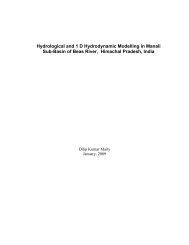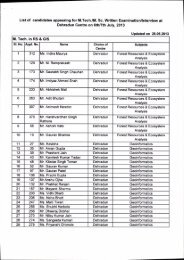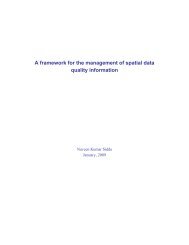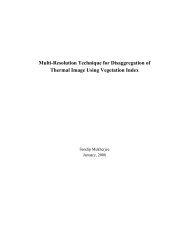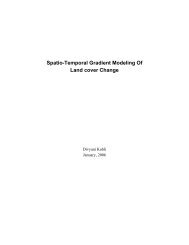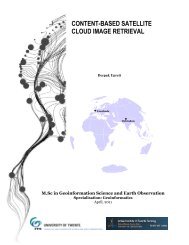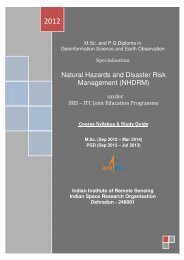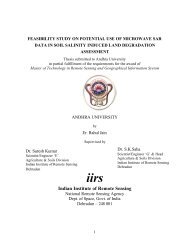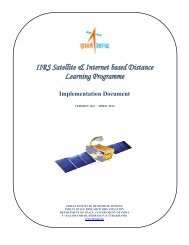Impact of Coal Mining on Vegetation: A Case Study in Jaintia Hills ...
Impact of Coal Mining on Vegetation: A Case Study in Jaintia Hills ...
Impact of Coal Mining on Vegetation: A Case Study in Jaintia Hills ...
You also want an ePaper? Increase the reach of your titles
YUMPU automatically turns print PDFs into web optimized ePapers that Google loves.
IMPACT OF COAL MINING ON VEGETATION: A CASE STUDY IN JAINTIA HILLS DISTRICT OF MEGHALAYA, INDIA3. Materials and Methods3.1. <strong>Study</strong> AreaThe Ja<strong>in</strong>tia <strong>Hills</strong> district <str<strong>on</strong>g>of</str<strong>on</strong>g> Meghalaya is bestowed with rich natural vegetati<strong>on</strong> as well as large reserve<str<strong>on</strong>g>of</str<strong>on</strong>g> m<strong>in</strong>eral resources. Dur<strong>in</strong>g the last few decades, there have been phenomenal <strong>in</strong>creases <strong>in</strong> m<strong>in</strong><strong>in</strong>g <str<strong>on</strong>g>of</str<strong>on</strong>g>coal, limest<strong>on</strong>e, sillimanite and clay caus<strong>in</strong>g large-scale destructi<strong>on</strong>s and deteriorati<strong>on</strong> <str<strong>on</strong>g>of</str<strong>on</strong>g> the naturalvegetati<strong>on</strong>. The district has been most extensively extracted <strong>in</strong> terms <str<strong>on</strong>g>of</str<strong>on</strong>g> coal, am<strong>on</strong>g all districts <str<strong>on</strong>g>of</str<strong>on</strong>g> thestate. Excessive m<strong>in</strong><strong>in</strong>g operati<strong>on</strong> <str<strong>on</strong>g>of</str<strong>on</strong>g> coal <strong>in</strong> many parts <str<strong>on</strong>g>of</str<strong>on</strong>g> the district has been resp<strong>on</strong>sible for thec<strong>on</strong>versi<strong>on</strong> <str<strong>on</strong>g>of</str<strong>on</strong>g> orig<strong>in</strong>al lush green landscape <str<strong>on</strong>g>of</str<strong>on</strong>g> the area <strong>in</strong>to m<strong>in</strong>e spoils. The crude and unscientificmethod <str<strong>on</strong>g>of</str<strong>on</strong>g> m<strong>in</strong><strong>in</strong>g adopted by the primitive operators <strong>in</strong> several parts <str<strong>on</strong>g>of</str<strong>on</strong>g> the district has caused severeecosystem destructi<strong>on</strong>. Unc<strong>on</strong>trolled and unscientific m<strong>in</strong><strong>in</strong>g operati<strong>on</strong> with<strong>in</strong> the district has beendetrimental to the fragile ecosystem. It is <str<strong>on</strong>g>of</str<strong>on</strong>g> urgent need to understand the impact <str<strong>on</strong>g>of</str<strong>on</strong>g> m<strong>in</strong><strong>in</strong>g <strong>on</strong> thevegetati<strong>on</strong> characteristics <str<strong>on</strong>g>of</str<strong>on</strong>g> the district for further management plan.For the present study an area <str<strong>on</strong>g>of</str<strong>on</strong>g> approximately 420 km 2 was del<strong>in</strong>eated <strong>in</strong> the core <str<strong>on</strong>g>of</str<strong>on</strong>g> the coal m<strong>in</strong><strong>in</strong>gareas <str<strong>on</strong>g>of</str<strong>on</strong>g> the district (92°13'52''E to 92°25'16''E l<strong>on</strong>gitudes and 25°16'7''N and 25°27'28''N latitudes).Lad Rymbai (25°21'53.2''N and 92°19'15.8''E), the major centre for coal m<strong>in</strong><strong>in</strong>g was taken as thecentre <str<strong>on</strong>g>of</str<strong>on</strong>g> the study area.3.2. MaterialsIRS Satellite data for four different years period <str<strong>on</strong>g>of</str<strong>on</strong>g> 1975, 1987, 1999 and 2001 were used for temporalanalysis. The data used are Landsat MSS for 1975, Landsat TM for 1987, Landsat ETM+ for 1999and IRS-1D-LISS III data for 2001 (Figure 3.1, Figure 3.2, Figure 3.3, Figure 3.4).The ancillary data used for the study are topographic maps <str<strong>on</strong>g>of</str<strong>on</strong>g> the study area, GSI map, GPS andCompass.The s<str<strong>on</strong>g>of</str<strong>on</strong>g>tware used are ERDAS IMAGINE 8.7, ArcGIS, ILWIS 3.2 and MS Office.3.3. Research MethodsTo fulfil the objectives follow<strong>in</strong>g methods will be adopted:3.3.1. <strong>Study</strong> Initiati<strong>on</strong>Identificati<strong>on</strong> <str<strong>on</strong>g>of</str<strong>on</strong>g> study area followed by literature review.3.3.2. Pre-Field WorkDel<strong>in</strong>eati<strong>on</strong> <str<strong>on</strong>g>of</str<strong>on</strong>g> study area followed by rec<strong>on</strong>naissance survey.3.3.3. Field and Post-Field WorkAnalysis and <strong>in</strong>terpretati<strong>on</strong> <str<strong>on</strong>g>of</str<strong>on</strong>g> four different years satellite data with the help <str<strong>on</strong>g>of</str<strong>on</strong>g> remote sens<strong>in</strong>g andGIS.21



